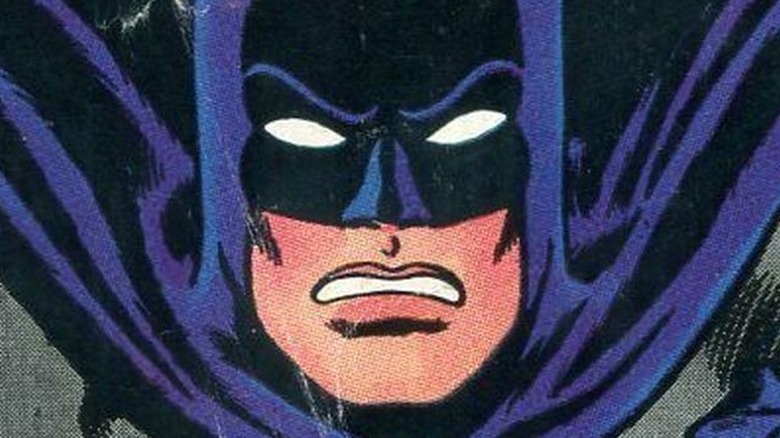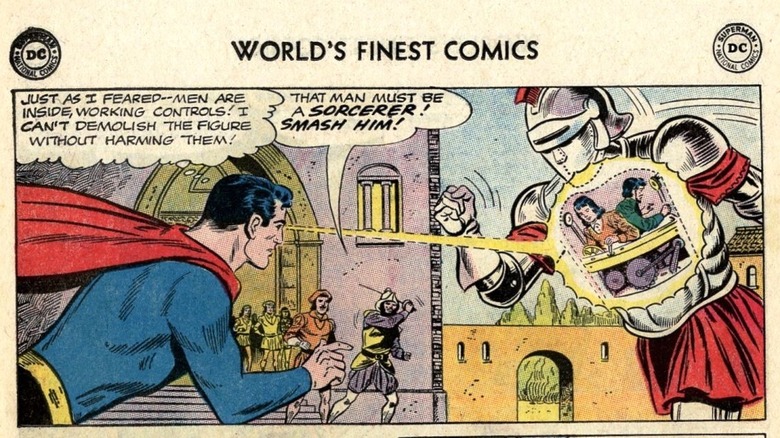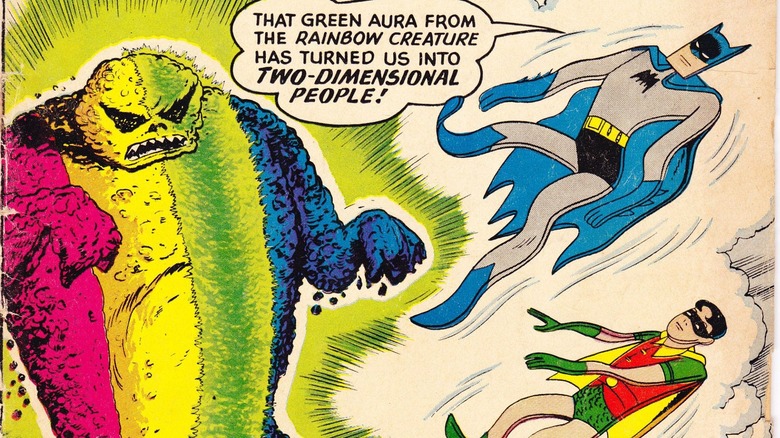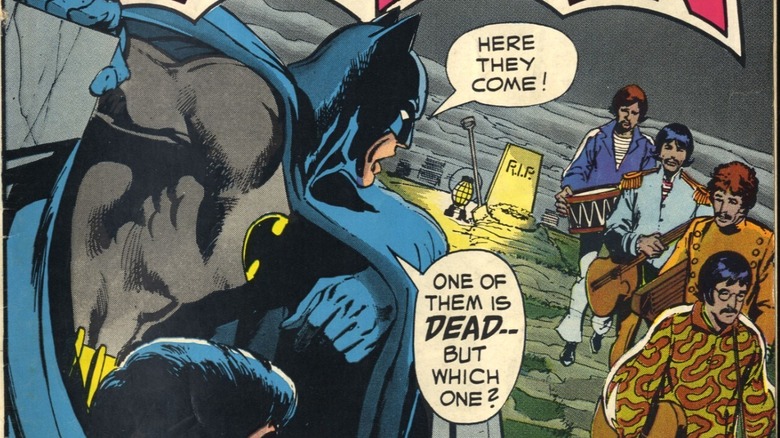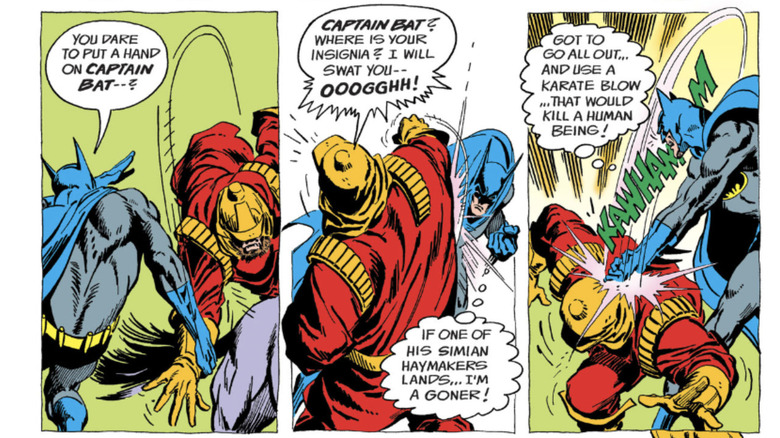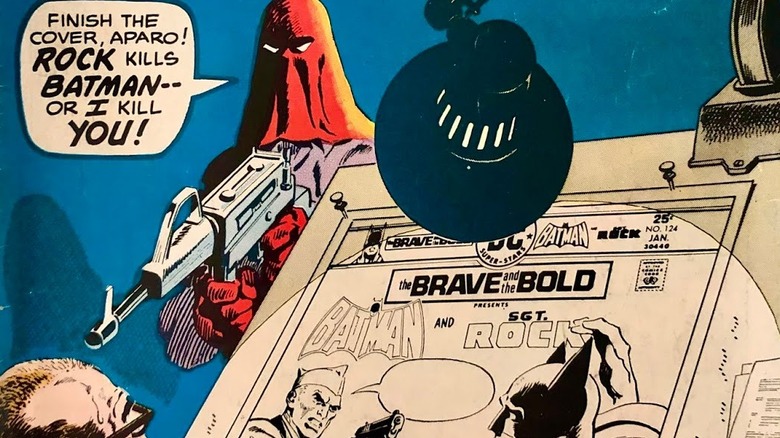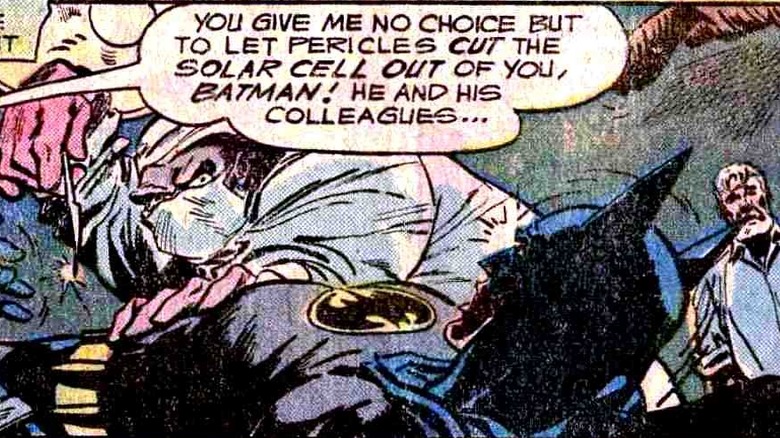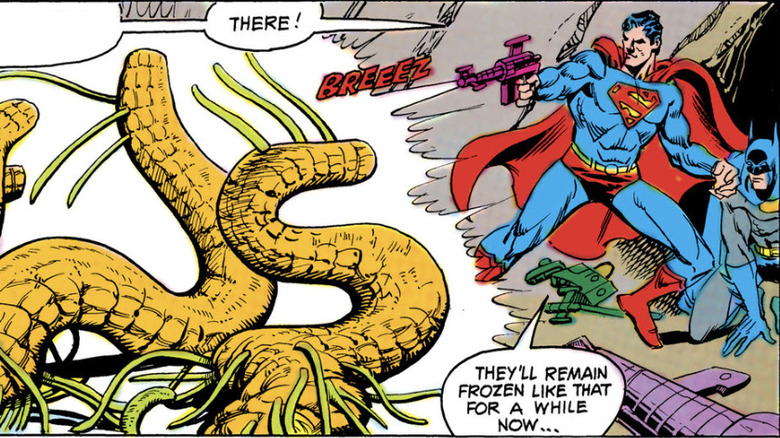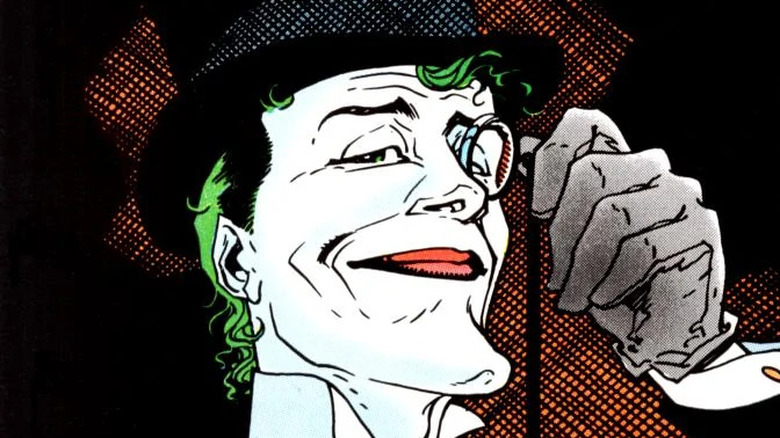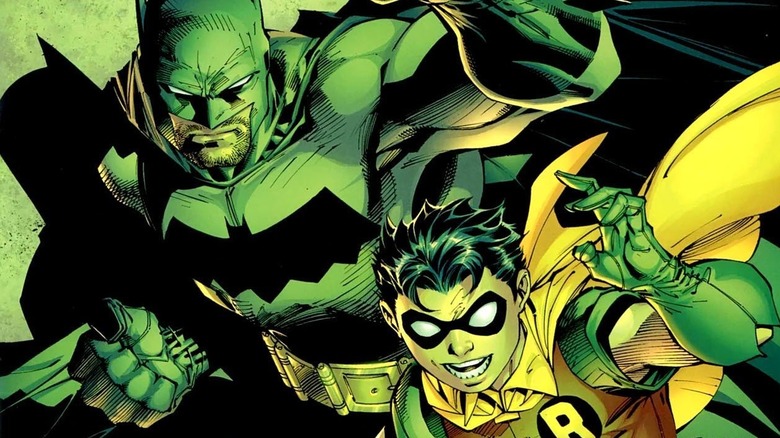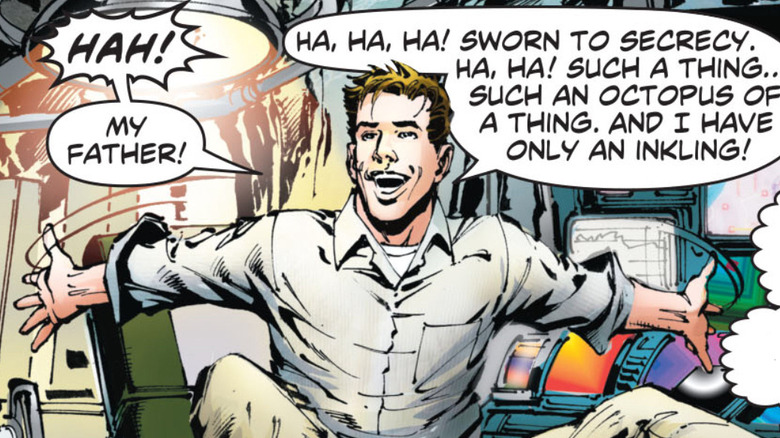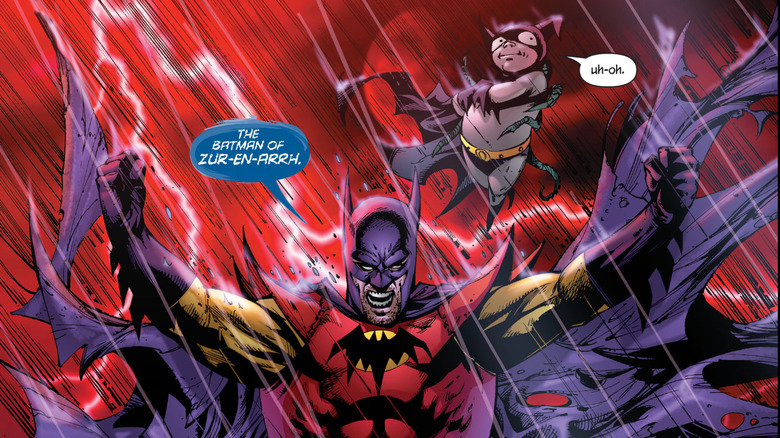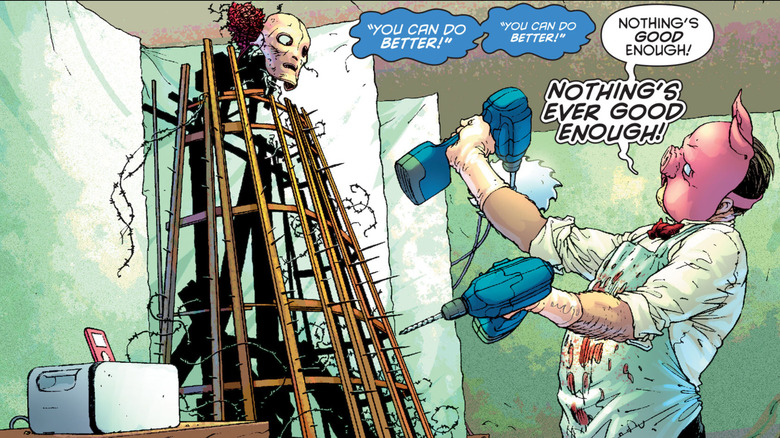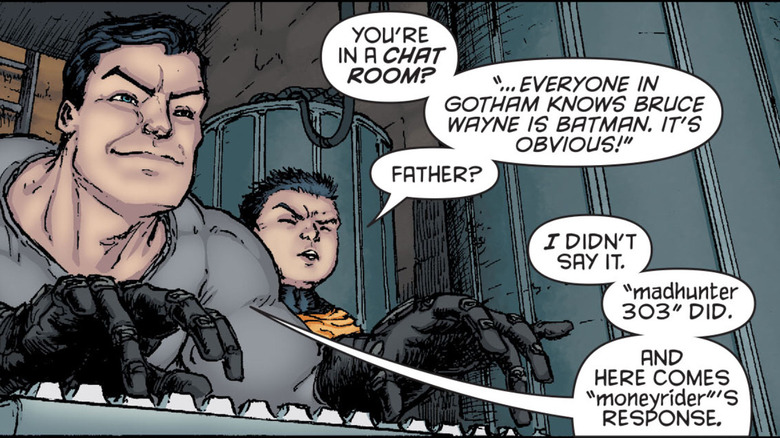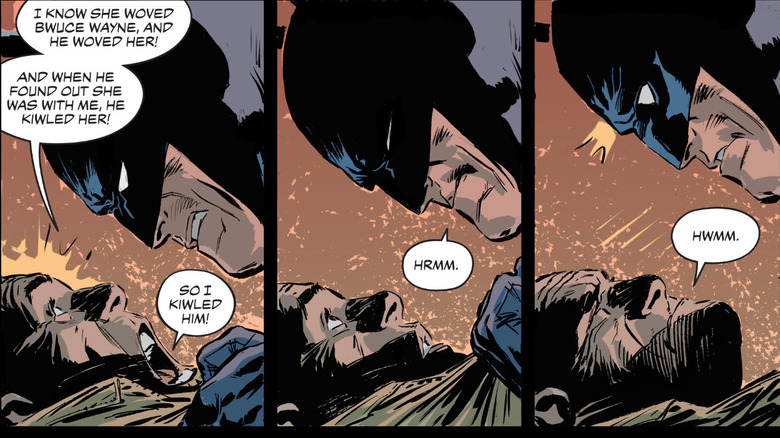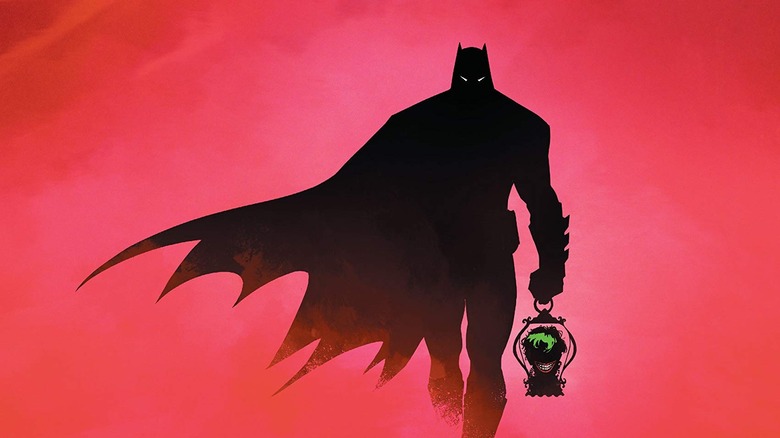The Weirdest Batman Comic Book Stories Of All Time
Fans will tell you the secret to Batman's appeal is how gritty and grounded he is compared to every other superhero. That's true as far as it goes, but by any other standards, Batman lives a strange, strange life. He's a genius detective, chemist, engineer, multi-linguist, martial artist, and probably ballerina too, who built a rocket-powered car with his face on it that he keeps in a cave under his house, along with a jillion other high-tech toys that must cost, at a conservative estimate, the liquid assets of every billionaire in America combined.
He regularly flies to the moon to give orders to the most powerful beings on Earth, despite having no powers to speak of except for the aforementioned mind-boggling amounts of money. His best friends are a teenaged acrobat in a canary-yellow cape and a space alien with laser eyes. As for his enemies, there's a killer clown who fell into a vat of industrial chemicals and came out with nothing worse than a dye job, who murders people with a chemical of his own invention that makes them laugh themselves to death. That's the one that caught on — never mind all the also-rans with their weird powers and weirder costumes.
This is just the stuff Batman fans take for granted, so you know that when one of the Dark Knight's adventures stands out as especially weird, it's gonna be real weird. See for yourself...
That time Batman met the Joker's ancestor in medieval Baghdad
Back in the day, Batman would meet with Dr. Carter Nichols to travel through history every other issue. Or at least that's what the comics want us to think — but, as comics blogger Jon Morris points out, the process involves hypnosis, which means Batman and Robin could just be passed out in Dr. Nichols' basement, possibly while he "rifles through their wallets."
Of course, the Dynamic Duo would only meddle with the very fabric of space and time when absolutely necessary. Like, for instance, to figure out what the deal is with some weird-looking rug. In "Batman" #49, Bruce Wayne and Dick Grayson find a thousand-year-old rug with the Joker's face on it. Since there were apparently no crimes being committed in the greater Gotham City area that night, Batman and Robin take the evening off for a trip to medieval Baghdad.
Even though they don't have any more specific directions than "a thousand years ago," the Dynamic Duo somehow end up on the exact same corner as the Joker's predecessor, the Crier. He blinds the people of Baghdad with tears, first by telling them Caliph Harūn al-Rashīd is dead, then by spraying the Caliph himself with onion juice. Then there's the truly disturbing weirdness of the story's resolution: they hold the Crier down and tickle him to reassure the people of Baghdad that his warnings of doom are just, you guessed it, a joke.
That time Superman saved Fake Batman and Robin from a robot
You'd think Batman and Robin would have a contingency plan for all their trips into the distant past, but apparently the best Carter Nichols can come up with is "let Superman deal with it." That's what happens when the Dynamic Duo get lost in Renaissance Florence in "World's Finest" #132.
Superman finds his superfriends about to be executed by a giant ancient Roman gladiator. The gladiator turns out to be a robot, leading to the hilarious image of Superman's X-ray vision revealing two fops calmly sitting at a desk in the robot's ribcage. Superman rescues Batman and Robin but then realizes they aren't Batman and Robin at all. They're Gotham gangsters Denny Kale and Shorty Biggs, who improbably have a big old boulder of Kryptonite on hand to chain to his chest so he can't rat them out.
As for the real Batman and Robin, a flashback reveals that Denny and Shorty took them out like a couple of chumps, stole their costumes, learned their identities, discovered a letter from Nichols, and decided to start a new career in an old town. Meanwhile, they leave Batman and Robin chained up with a time bomb. Once they escape, the Dynamic Duo free Superman and help him catch their doubles, saving their secret identities with a half-baked explanation involving knocking over a table full of chemicals.
That time a rainbow monster turned Batman into Flatman
If there's one thing DC did in the Silver Age of the '50s and '60s, it was weird, freaky monsters with weirder, freakier powers, and it's sure hard to think of a weirder monster than the Rainbow Creature from "Batman" #134. This psychedelic monstrosity is already turning Batman and Robin into paper people before you can even open the cover.
Batman's just helped the president of an anonymous South American country fend off a revolution when the Rainbow Creature shows up. Where did it come from? Well, rebel leader Diaz shows up, dressed as a conquistador for some reason, and claims to have "created" it, while Batman insists it's "a freak of nature — spawned by the volcano," which is all the answer we're ever going to get. Batman uses this tidbit he learned to prove Diaz can't control the monster, turning the people against him.
As for the Creature itself, Batman's brilliant plan after getting it to burn out its powers is to ram it with a stick — let's not forget El Presidente has plenty of perfectly good cannons lying around — which, for whatever reason, disintegrates it. Ahead of the release of "The Suicide Squad," director James Gunn tweeted the also-ran characters he considered for the movie, including the Rainbow Creature. We love Starro as much as anybody, but we don't know if we can ever forgive Gunn for turning down the chance to put this thing onscreen instead.
That time Batman put Superman on trial because future apes said to
In "World's Finest" #183, Batman gets a visit from two metal-masked future dwellers who promise him indisputable proof that Superman needs to be tried and lobotomized for future crimes. After Batman slips his super-best friend the ole kryptonite, the Man of Steel stands trial in front of the United Nations.
The future people claim that two days in the future, Superman's experiment on the unpredictable red variant of kryptonite that once turned him evil will backfire spectacularly. It will turn him permanently evil and inspire him to commit supercrimes like sinking ocean liners, demolishing the Taj Mahal, and burning libraries to the ground. So he's on trial for all that untold death and destruction, right?
No, the time travelers insist he committed a far worse crime: building a giant satellite shaped like himself and using it to turn everyone into monkey people. For "proof," they unmask to reveal their simian faces. The future apes provide the UN with a lobotomy ray they promise will keep Superman from turning evil, which does the exact opposite. Then they pull off a second set of masks to reveal Superman's nemeses Brainiac and Lex Luthor. What was the reason for this elaborate plot? Luthor and Brainiac figure that if Superman was evil, he'd be their friend. But Superman, of course, has faked his whole rampage and hauls Luthor and Brainiac off to jail, where they'll hopefully build some healthier relationships.
That time Batman got in on the 'Paul is dead' conspiracy theory
Marvel roundly whupped DC's butt throughout the '60s, due in no small part to Stan Lee's promise to show readers "the world outside your window." While the DC Universe bore only the most cosmetic resemblance to reality, Marvel tackled subjects like Vietnam, drug addiction, and civil rights.
As the decade continued, DC tried to follow Marvel's lead, but the results were mixed to say the least. "Batman" #222 featured a story ripped straight from the headlines — of a conspiracy theory pamphlet. In "Dead...Till Proven Alive," Batman and Robin investigate the Beatles — sorry, the "Oliver Twists" — to see if it's true that Paul McCartney — sorry "Saul Cartwright" – has died and been replaced with a double.
Batman and Robin invite the band — including a tinted-glasses-favoring vocalist named "Glennan" — to spend the night at stately Wayne Manor. While no doubt dozens of murders go unsolved, the Dynamic Duo spend the whole night at work analyzing tapes of Saul's voice to see if it's really him. In the (Oliver) twist ending, Batman discovers Saul is the only original member because the others were — and we swear, this is a direct quote — "killed last year in a private jet that was taking them to groove with the mysteries of the East!"
Oh, and despite Neal Adams' cover, there isn't a single clue on the album cover, so feel free to sue for false advertising.
That time Batman led an army of gorillas to bears of the future
No one knew how to tell a weird-as-all-heck Batman story quite like Bob Haney. During his run on "The Brave and the Bold" with artist Jim Aparo, he disregarded the rules of DC continuity and just plain common sense so often that the editors decided his stories must take place in a parallel universe. As you might guess from the description above, #120 is no exception.
"This Earth Is Mine" teams Batman up with Kamandi, the Last Boy on Earth — the unsung masterpiece of Marvel architect Jack Kirby's turbulent time at DC – for a trip to the animal-ruled Earth A.D. (After Disaster). "This Earth Is Mine" opens with Kamandi running from a gorilla cavalry squad led by "Captain Bat" — aka Batman. We eventually get an explanation for all this, and it's a doozy: In Earth A.D., bear people sacrifice to the "gods" of Mount Rushmore, who respond by singing "The Star-Spangled Banner." After Batman lassos the cleft in George Washington's chin, he and Kamandi find a human settlement, who have summoned Batman using "certain ancient Indian magic powders" they found in the old cave and a pre-Disaster issue of "The Brave and the Bold."
The spell dropped Batman in front of a gorilla army, so he clobbered their general and declared himself their new leader. For some reason, everyone assumes he's an actual bat-man, and even though those creatures have already been established as part of Kamandi's world, Batman's tights don't exactly make the most convincing disguise.
That time some villains held Batman's artist hostage
"The Brave and the Bold" #124 starts with Batman pulling off an old-man mask that he somehow fit over his cowl without anyone realizing it's not his real face, and escalates from there. Batman and DC's war-comics hero Sergeant Rock are on the trail of the 1,000, a terrorist group that's stolen a truckload of high-tech experimental rifles to further their goals of ... something. But we don't have time to sort that out, since the action moves to artist Jim Aparo in his studio with Bob Haney's script. He sees he's supposed to draw the 1,000 killing Rock and Batman and asks, "What's that crazy writer done now?"
What indeed. In the next panel, the 1,000 show up inside his studio, holding Aparo at gunpoint to change the outcome of their own story. It was nothing new for DC's scripters to write themselves into their stories, but until now they'd always been safely separated from their characters in the real world, or "Earth-Prime" in DC's cosmology. But Haney turns that concept mind-meltingly bizarre by making it clear that the story is being written and taking place at the same time and in the same reality. Aparo even draws Batman saving him from the terrorists as they approach the lighthouse where he's hiding out. This would make Haney and Aparo godlike beings who can control the world around them with the stroke of a pen — but then, isn't that every writer's dream?
That time Batman and Wonder Woman fought a gorilla surgeon
"The Brave and the Bold" #140 doesn't waste time getting to the weirdness: Page one shows a ringmaster cracking a whip at the chained-up heroes, demanding they "roar like a lion" and "purr like a tigress." Maybe Jim Aparo accidentally slipped some of his "personal" art into the comic. Then we find out how the heck we got here: The man is Dimitrios, and both Batman and Wonder Woman sneak on his ship to bring him in for stealing an experimental solar cell. Wonder Woman has a much easier time boarding than Batman, who scubas into a pipe that leads directly into an aquarium full of sharks and octopi. But that's the least strange of the ship's amenities, which also include recreations of the Wild West, the Arctic, and Gotham City. Dimitrios sends his "Simian Squad" — that's right, more gorillas — to track the heroes down, eventually leading to that kinky circus scene from the beginning.
Dimitrios is awfully careless with his priceless solar cell, and he shows it off by tossing it high enough in the air for Batman to lunge forward, pretend to swallow it, and run off. Eventually, the Simian Squad catches him and one of the gorillas, in full scrubs, prepares to cut the cell out of him. It all ends with Batman delivering one of the strangest lines of his career, even in context, when Wonder Woman asks where he's going: "To start a medical school for gorillas."
That time Batman and Superman cried over space slugs
"World's Finest" #289 tells the thrilling story of Superman and Batman getting real sad. Batman, at least, has a good reason after failing to prevent a murder. Superman, meanwhile, pulls off a flawless rescue, but still gets in a mood when he remembers how his home planet blew up. Somehow Superman senses Batman needs a shoulder to cry on, so he flies his buddy off to the Fortress of Solitude, where an apparent meteor shower turn out to be spaceships controlled by weird, tentacle-covered slug things. They explain they were sent by the Kryll, aliens that pursued immortality by progressively replacing more and more of their bodies and minds with machinery, eventually losing the ability to feel. The slugs explain they were drawn to the strong emotions emanating from the Fortress, which sure seems like a nice way of calling Batman and Superman crybabies.
Then the second set of slugs arrives. They're symbiotes, intended to receive the emotions the first set has collected, a process that involves — there's really no other way to put this — space slugs getting busy. The receivers provide openings for the collectors to slither into, which as a family site we're not showing you, although apparently it was hunky dory at DC.
Then they die, and Batman and Superman have a good cry about it. How do you sell a story like this? DC didn't even try — Gil Kane's cover just shows a generic image of Superman flying while Batman's giant face looms behind him.
That time the Joker became an ambassador to the UN
Jim Starlin and Jim Aparo's "A Death in the Family" is one of the essential Batman stories: the death of Jason Todd, the second Robin. The Dark Knight's failure to save him from the Joker would haunt him for the rest of his career, and the story paved the way for Todd to return decades later as the Red Hood.
But for all its importance, there's still a lot in "A Death in the Family" that makes no sense. Even if they haven't read it, most Bat-fans should be familiar with the weirdness of DC leaving Robin's fate up to their readers via a 1-800 number. But that isn't even the strangest thing about this story. The Joker flees the country after his latest prison break with a stolen nuclear missile launcher and plans to sell it to any terrorist group that will take it. But the reassembled launcher doesn't blow up anything but itself. Somehow, a career of mass murder and one spectacularly failed nuclear launch qualifies you to represent Iran to the United Nations, because as the Joker flees the scene of Robin's murder, he gets a job offer from Ayatollah Khomeini.
This sets up a quandary for Batman, since "diplomatic immunity" keeps him from bringing the Joker to justice. But as literally anyone could have predicted, the Joker's first act of diplomacy is trying to set off a suicide bomb in the UN general assembly, which apparently has looser security than the average 7-11.
That time a comics legend drove Batman straight off the rails
Ask just about any Bat-fan to name their top two stories, and odds are both of them would be by the same man — Frank Miller, writer of "Year One" and writer-artist of "The Dark Knight Returns." But when he teamed up with Jim Lee for "All-Star Batman and Robin the Boy Wonder," the series' legacy wasn't redefining the character forever, but rather a single line of ludicrous dialogue going viral.
Oh, but that's still not the most ridiculous thing in "All-Star." For one thing, Miller seems to have caught wind of how far that line took off because he tops himself a couple issues later. His trademark stylized, pulpy dialogue has devolved into mind-numbing repetitiveness. Just look at Robin's opening narration: "They're always there for me. They always catch me. Mom and Dad. They always catch me. They're always there for me."
If "The Dark Knight Returns" turned Batman into an antihero, "All-Star" turns every child's idol into an abusive monster, beating Robin and forcing him to hunt in the cave for his meals. The rest of the heroes look even worse, which at least gives the series a chance to be the fun kind of ridiculous for a change: When the Justice League sends Green Lantern to chew Batman out for kidnapping Robin, he paints his entire safe house yellow (Green Lantern's one weakness) and smugly sips on a glass of lemonade.
That time a different comics legend drove Batman straight off the rails
If there's anyone who contributed more to Batman than Frank Miller, it's Neal Adams. In the late '60s, when "Batman" still meant the colorful TV series' goofy do-gooder, Adams and writer Dennis O'Neil reinvented the Dark Knight as the dark and troubled soul we know today. So what happens when you're such an icon that no one will say no to you? You get "Batman: Odyssey."
Every page of "Odyssey" seems to come direct from Adams' fevered subconscious. One character's name changes from "Reuben Blades" (confusing fans of the salsa pioneer everywhere) to "Reuben Irons" and back again. There are about five timelines and 10 levels of stories within stories going on at any given moment, and there's no way to tell which is which.
It'd be difficult to explain 13 issues of plot in a single paragraph, but fortunately, Adams doesn't do much of a job explaining the plot either, so we'll just follow his lead and drop a bunch of random events on you. Every issue opens with an apparently naked Bruce Wayne literally getting in the reader's face as he narrates. A villain unleashes Seussian bees with long, stripey stingers on the wrong end. A single panel introduces aliens, Egyptian gods, and jazz magicians into a story that's already packed to bursting.
In other words, it's endless incomprehensible gobbledygook. But it also features Batman fighting machine-gun-wielding dinosaur riders from the back of a giant bat, so can we really judge?
That time Batman created a backup personality
Nobody in comics loves weird quite like Grant Morrison. And in "Batman R.I.P.," they turned one of Batman's weirdest adventures even weirder.
In "Batman" #113, the Caped Crusader was summoned to the planet Zurr-en-Arrh by another Batman, who the original's adventures inspired to fight crime in a ... let's say "unique" version of his costume. In "Batman R.I.P.," running through "Batman" #676–681, Morrison reveals the whole episode was a hallucination during Batman's experiments in an isolation chamber overseen by a mysterious figure named Simon Hurt. He claims to be Batman's father, "proving" in #677 that he faked his death and murdered Martha Wayne for cheating on him with Alfred. Back in the isolation chamber, Hurt had seized on the name "Zurr-en-Arrh" and planted it as a post-hypnotic suggestion in Bruce's brain to break him completely, activating it by spray-painting it all over Gotham. Wandering the streets, Batman stitches together a new suit out of rags and returns to Wayne Manor for revenge.
#681 reveals that years earlier, Batman had studied with a Buddhist monk to "create an emergency personality ... a back-up human operating system." That issue ends with Morrison showing off their uncanny skill for weaving together bits of Batman's history to explain how "Zurr-en-Arrh" got so embedded in his unconscious in the first place. It's a garbled version of his father's last words as the Waynes left that fateful screening of "Zorro": "The sad thing is, they'd probably throw someone like Zorro in Arkham."
That time Batman fought a free-association-themed supervillain
Grant Morrison didn't let up on the weirdness for a second when they and artist Frank Quitely relaunched the title as "Batman and Robin." After Bruce's apparent death, Dick Grayson, the original Robin, takes over as Batman with Bruce and terrorist Talia al Ghul's son Damian as his Robin.
Most of the time, you know where you stand with Batman villains. They have a theme, and they'll build all their crimes around it: jokes, riddles, umbrellas, the number two, and so on. Then there's Professor Pyg. Despite the name and the mask, he doesn't care about barnyard animals. He's kind of a reverse version of the mythological Pygmalion: instead of carving a statue that comes to life, he "perfects" living people by turning them into "Dollotrons." So his sidekicks must be either animal or doll-themed, right? Nope, unless you want to count Mr. Toad, whose resemblance to a five-foot amphibian is never explained. They seem to share a love for fast cars. The rest of Pyg's crew are all circus freaks: tumblers, a man with a flaming head, and an enormous bearded lady named "Big Top."
Then there are the mommy issues, specifically that his "mommy" is a surrealist sculpture made of barbed wire, plywood, and a Dollotron mask. Robin says it best: "You just redefined wrong."
That time Batman protected his secret identity with the power of trolling
Every couple years, this Tumblr post resurfaces, where blogger "raptoriffic" imagines Bruce Wayne deflecting suspicions that he's secretly Batman by posting ridiculous conspiracy theories, most memorably circling images of Bruce and Batman's butts (obscured by a coat and cape, respectively) with the text "THE BUTTS MATCH!!!" to turn the whole possibility into a joke.
But what "raptoriffic" either didn't know or didn't mention is that when they posted, this had already been canon for five years.
Bruce Wayne, of course, wasn't dead, just rocketing through time in "The Return of Bruce Wayne" as a caveman-pirate-cowboy, as one does. He comes back with a mission: to make his war on crime bigger than ever, and in "Batman Incorporated," we see what that looks like.
In Vol. 1, #6, Grant Morrison and Chris Burnham show Bruce Wayne publicly declaring he'll be funding the new super-team. Back at the Batcave, Dick and Damian find him hunched over the computer, with an expression that looks an awful lot like the contemporary "trollface" meme, anonymously announcing his secret identity in a chatroom. "Attempts will shortly be made to expose the secret identities of Batman and his allies ... When they happen, they'll be lost in a blizzard of rumor, denial, and misinformation." Within seconds, the chatroom proves him right, flooding with all three of those things. Nothing about the butts matching, unfortunately.
That time Batman fought Elmer Fudd -- and almost lost
Most of the time, "corporate synergy" is just a nice way of saying "tacky cash-in." But every once in a while, it produces something wonderful, like Tom King and Lee Week's "Batman/Elmer Fudd" one-shot. AT&T's ownership of both Warner Brothers and DC Comics has opened the door to a series of "Looney Tunes" crossovers, and while "Batman/Elmer Fudd" isn't the best — for that, you have to go to Gail Simone and Inaki Miranda's hysterical "Catwoman/Tweety and Sylvester" — it's a darned close second.
The story recasts Elmer Fudd as a hardnosed, haunted hitman, seeking revenge for his lover's murder. He's a surprisingly competent one too — he shoots Bruce Wayne in a crowded ballroom and walks off scot-free. When it seems Batman has snuck up on him, Elmer fires over his shoulder at him without even turning around. The story begins with Elmer trailing a human version of Bugs Bunny to Porky's bar, which is packed with all kinds of twists on the classic characters — including one that's not a twist at all, just Hubie the Mouse standing in the background surrounded by realistic people. Bugs, of course, talks his way out of getting "bwasted" by telling Elmer that Bruce Wayne paid him to do the deed. The best part? This is all canon. Porky's bar appeared many more times throughout King's "Batman" run, still with its stuttering bartender and looney clientele.
That time Batman wandered a wasteland with Joker's head
In 2021, Scott Snyder and Greg Capullo ended their decade-long collaboration on Batman by imagining the end of his career in "Batman: Last Knight on Earth." Batman wakes up in Arkham Asylum, learning that the past 80 years of adventures were a delusion and his "enemies" were actually his doctors. But even that turns out to be an illusion Alfred created to spare Bruce the truth: that the universe has torn itself apart. In the chaos, a mysterious figure named Omega has taken control, killed the godlike Darkseid and stuck his head on a pike, and stolen his power over the Anti-Life Equation to end free will on Earth.
There's plenty of weirdness filling this post-apocalyptic landscape. Green Lantern rings rain from the sky, and ordinary people without the will to control them are dragged limply along by giant green babies. But strangest of all is the Joker's role in all this. Batman finds the Joker's severed head in a hanging lantern in the middle of the desert. Believe it or not, all that forced isolation improved the Joker's disposition, and he plays the role of Batman's faithful, if smart-mouthed, sidekick. He even, after spending the whole series asking, gets to be the new Robin, thanks to a power suit left behind by Tim Drake.
